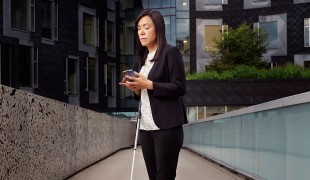- 9208
- 576
- 9
- 10
- 0
- Help Ukraine
About the solution
Gary’s inventions enable lots of people with conditions such as cerebral palsy, autism, traumatic brain injury, stroke, and ALS to speak.
In addition to cerebral palsy, the EyeMax is designed for those with other conditions that mean they can't communicate verbally or through touch, such as those affected by motor neurone disease, spinal cord injuries, locked in syndrome and other similar conditions.
The technology works in combination with either of DynaVox’s two hardware devices called the Vmax+ and Maestro, which offer different benefits for the user. The Vmax+ is a 12-inch screen that allows the operator to communicate through a traditional keyboard or the InterAACt software that uses symbols, photos, words or letters, exclusively or in combination. Maestro is the company's more compact and lightweight system which also allows the user to also capture memories through an integrated camera.
One of the key advantages of the InterAACt software is the freedom of expression it allows individuals to have, and the ability to use age appropriate language. Three settings are available, children, teens and adults, with words and language tailored to each age group. Environment choices also allow individuals to use phrases specific to that location such settings for birthdays, the workplace or shopping trips.
More info: http://www.tobiidynavox.com/
Adapted from: http://bit.ly/2eZFqzI
What about you, do you have any solutions? Please share them with the Patient Innovation community!
This solution shall not include mention to the use of drugs, chemicals or biologicals (including food); invasive devices; offensive, commercial or inherently dangerous content. This solution was not medically validated. Proceed with caution! If you have any doubts, please consult with a health professional.
DISCLAIMER: This story was written by someone who is not the author of the solution, therefore please be advised that, although it was written with the utmost respect for the innovation and the innovator, there can be some incorrect statements. If you find any errors please contact the patient Innovation team via info@patient-innovation.com
-
-
763
-
0
-
17054

Proloquo2Go – App to help people communicate
CAREGIVING
COMMUNICATION: Communicating, whether by speaking, listening, or other means
Social interaction
Paralysis
Autism
Cerebral Palsy
Brain Stroke
Brain Injury (Abscess, Brain Barrier Defect, Brain Contusion, Brain Hemorrhage, Brain Edema)
Assistive Daily Life Device (to help ADL)
Assistive Technology access
App (Including when connected with wearable)
Tremors
Muscle cramps or spasms
Difficulty coordinating movements
Muscle weakness
Difficulty speaking or understanding speech
Trouble with fine motor skills (e.g., writing, buttoning clothes)
Twitching or involuntary movements (myoclonus)
Acquired language impairment (Aphasia)
Promoting self-management
Managing Neurological Disorders
Building Supportive Community Relationships
Promoting inclusivity and social integration
Improving Speech and Communication
Caregiving Support
Clinical Pathology
Medical Genetics
Neurology
Pediatrics
Rheumatology
Netherlands
-
-
-
474
-
0
-
6534

Blind woman develops several technologies to help the blind
CAREGIVING
Reading
Studying
COMMUNICATION: Communicating, whether by speaking, listening, or other means
Blindness
Assistive Daily Life Device (to help ADL)
Assistive Technology access
Vision problems
Recovering cognitive function
Promoting self-management
Preserving Organ Function
Managing Neurological Disorders
Promoting inclusivity and social integration
To improve Treatment/Therapy
Preventing (Vaccination, Protection, Falls, Research/Mapping)
Ophthalmology
United States
-
-
-
260
-
0
-
3618

Mother develops BeMe.ai, an app to track and support autistic individuals, their families and care teams
COMMUNICATION: Communicating, whether by speaking, listening, or other means
CAREGIVING
Autism
App (Including when connected with wearable)
Managing pain
Enhancing health literacy
Promoting self-management
Managing Neurological Disorders
Building Supportive Community Relationships
Promoting inclusivity and social integration
To implement a diagnostic tool
Enhancing Mental Health
Improving Speech and Communication
General and Family Medicine
Internal Medicine
Medical Genetics
Neurology
Pediatrics
Psychiatry
Canada
-
 en
en